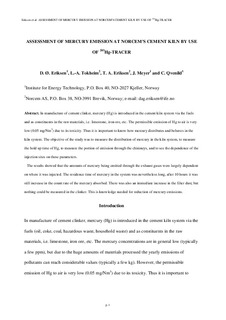| dc.description.abstract | In manufacture of cement clinker, mercury (Hg) is introduced in the cement kiln system via the fuels and as constituents in the raw materials, i.e. limestone, iron ore, etc. The permissible emission of Hg to air is very low (0.05 mg/Nm3) due to its toxicity. Thus it is important to know how mercury distributes and behaves in the kiln system. The objective of the study was to measure the distribution of mercury in the kiln system, to measure the hold up time of Hg, to measure the portion of emission through the chimneys, and to see the dependence of the injection sites on these parameters. The results showed that the amounts of mercury being emitted through the exhaust gases were largely dependent on where it was injected. The residence time of mercury in the system was nevertheless long, after 10 hours it was still increase in the count rate of the mercury absorbed. There was also an immediate increase in the filter dust, but nothing could be measured in the clinker. This is knowledge needed for reduction of mercury emissions. | |
